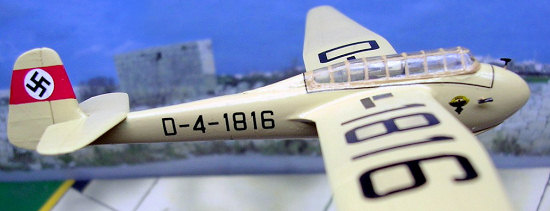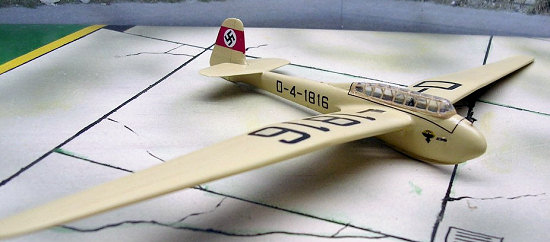
Czech Master 1/72 DFS Kranich Glider
| KIT #: | ? |
| PRICE: | ? |
| DECALS: | Two options |
| REVIEWER: | Carmel J Attard |
| NOTES: | Resin |

| HISTORY |
The Kranich was designed by Hans Jacobs and was built in the autumn 1935. This he has developed from the single seat Rhonsperber into an enlarged version. Several hundreds were built in Germany before and during the war. Other Kranichs were built in Spain, Sweden, and Czechoslovakia. After the war Kranichs continued to be built in Yugoslavia, Poland and Spain.
The early two seat Kranich was mass produced during its long life. Its high performance enabled it to break almost every record. The Kranich 2 were built in much greater number than the Kranich 1. It was stronger and with room in the front cockpit, had large dive brakes and other small changes to the ailerons for lighter handling during flight.
 One of the main methods of training German military pilots
was gliding. The German youth movement attached to gliding, equivalent to the
British Air Training Corps, used several types of sailplanes which were modified
for use by NS.Fliegerkorps and the Luftwaffe. The Kranich was selected to be the
standard, high performance two-seater. In this machine dual instruction could be
given in every aspect of flying including blind flying and use of oxygen and
radio.
One of the main methods of training German military pilots
was gliding. The German youth movement attached to gliding, equivalent to the
British Air Training Corps, used several types of sailplanes which were modified
for use by NS.Fliegerkorps and the Luftwaffe. The Kranich was selected to be the
standard, high performance two-seater. In this machine dual instruction could be
given in every aspect of flying including blind flying and use of oxygen and
radio.
Kranich also took part in military operations at the front. At least on one occasion Kranichs, towed by Junker Ju-87B Stukas were used to transport petrol to surrounded Panzers in Russia. A 50 gallon fuel load was carried in the rear seat position. The towed Kranichs were released at some distance from the tanks. The Stukas continue on to attack the enemy and the Kranichs approach selected places to land in marked field beside a wood in which tanks were hidden. The tank crews then refueled their tanks and demolish the glider with explosive. The pilots made their escape on foot. 80 Kranichs were prepared for possible use in planned invasion of Britain.
 After 1945 there were five Kranichs in Britain. Cambridge
University Gliding Club owned a DFS30 Kranich 2.The Royal Navy had a Kranich 1
and a Kranich 2.Another Kranich 2 is thought to have been in Farnborough. All of
these came from Germany .The Cambridge Kranich (BGA494, G-ALKH, see British
civil register June 1948 to April 1950) after a career in Britain went to Eire,
and finally destroyed during a filming in the 60s in which J.Chochrane was
involved.
After 1945 there were five Kranichs in Britain. Cambridge
University Gliding Club owned a DFS30 Kranich 2.The Royal Navy had a Kranich 1
and a Kranich 2.Another Kranich 2 is thought to have been in Farnborough. All of
these came from Germany .The Cambridge Kranich (BGA494, G-ALKH, see British
civil register June 1948 to April 1950) after a career in Britain went to Eire,
and finally destroyed during a filming in the 60s in which J.Chochrane was
involved.
During the early 60s further Kranichs were imported into Britain from Sweden and some that the RAF bought came from Germany, possibly as many as seven in number.
The Kranich had one drawback which was the lack of vision from the rear cockpit. This improved with the canopy removed. However instructors became used to the poor visibility even with the rear canopy in place. Designers from different countries tried to improve on the Kranich. Yet it still seemed in the 1970s that no other club two- seater could match the Kranich for all-round performance and handling.
| THE KIT |
This is a 1/72-scale resin kit. Construction is simple with all the resin parts fitting so precisely once they are trimmed from the resin runner. Perhaps the only instance that one has to take extra care is during the fitting of the mainplanes to the fuselage. These have two locating pins, which are very useful to align the wings to the fuselage however one has to ensure that they dry with the correct dihedral. To get this correct one should refer to the front elevation of the 3-view drawing supplied along with the instructions.
| CONSTRUCTION |
 The
cockpit area is hollowed out into which are fitted a pair of seats in tandem,
the control columns, instrument panels, and a detailed coaming fitted in between
the front and aft seat. The rudder is an integral part of the fuselage part. The
horizontal tailplane is a single piece and is glued in place ahead of the fin.
Two underfuselage skids are supplied. Instruction is not quite clear as to which
one fits the type for which markings are issued. A quick check with reference
material gave me indication that the German ones I choose to do had plain skids
while post war types like those in service with the Swedish AF had the type that
contains tiny distance pieces to go between the fuselage and the skid. Kit also
contains tiny resin parts to represent the Pitot tube and air speed indicator.
These needed a 0.4mm blind hole to be drilled on the front fuselage ahead of
cockpit as indicated on drawings supplied with the kit. There are also two
rectangular holes close to the wing root to take two small clear plastic pieces
that fits exact
The
cockpit area is hollowed out into which are fitted a pair of seats in tandem,
the control columns, instrument panels, and a detailed coaming fitted in between
the front and aft seat. The rudder is an integral part of the fuselage part. The
horizontal tailplane is a single piece and is glued in place ahead of the fin.
Two underfuselage skids are supplied. Instruction is not quite clear as to which
one fits the type for which markings are issued. A quick check with reference
material gave me indication that the German ones I choose to do had plain skids
while post war types like those in service with the Swedish AF had the type that
contains tiny distance pieces to go between the fuselage and the skid. Kit also
contains tiny resin parts to represent the Pitot tube and air speed indicator.
These needed a 0.4mm blind hole to be drilled on the front fuselage ahead of
cockpit as indicated on drawings supplied with the kit. There are also two
rectangular holes close to the wing root to take two small clear plastic pieces
that fits exact ly in the space provided. These are intended for the back seater
to have a share of the view below the aircraft during flight.
ly in the space provided. These are intended for the back seater
to have a share of the view below the aircraft during flight.
The last piece to add to the kit is the clear acetate cockpit canopy, two of which are provided one of which being extra. These also contain fine raised frame lines, which should facilitate painting of the glasshouse type of frame. Close examination of the side views will indicate that close to the leading edge area and beneath the wing there is a small rectangular raised panel that is omitted on the kit but which is very easily made out of a small plastic card 1/32 inches thick. There is one on each side and should be added, as these are present on all the Kranich photos I have seen. One suggestion I feel should say is that CMR should consider issuing a twin- wheel dolly that goes under the fuselage and which are detached once the glider is airborne. I have scratch built a dolly trailer that gives a different aspect to the model when displayed at dispersal.
| COLORS & MARKINGS |
The two sets of decal markings are of good quality and almost identical. Tail unit swastika are supplied for both having a red stripe background. The overall cream scheme turns it into a very attractive model glider especially once the large overawing black registration decals are put in place. It may be wise to note at this stage that it would be a good idea if one considers adding the CMR kit of the G3 Rhonsperber glider out of which the Kranich has evolved.
| CONCLUSIONS |
The Kranich has turned into yet another interesting addition to my scale aircraft collection.
April 2007
Copyright ModelingMadness.com. All rights reserved.
If you would like your product reviewed fairly and fairly quickly, please contact the editor or see other details in the Note to Contributors.
Back to the Review Index Page 2021